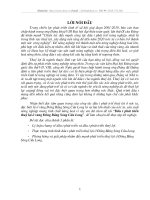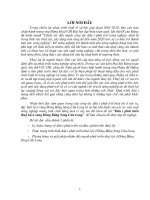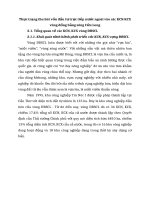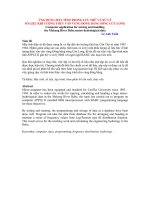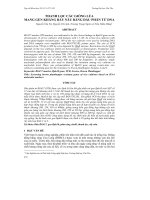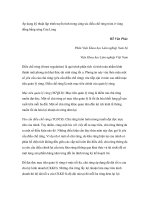Sử dụng các dấu phân tử thanh lọc các giống lúa mang gen kháng rầy nâu vùng Đồng bằng sông Cửu Long
Bạn đang xem bản rút gọn của tài liệu. Xem và tải ngay bản đầy đủ của tài liệu tại đây (546.39 KB, 27 trang )
MINISTRY OF EDUCATION & TRAINING
CAN THO UNIVERSITY
BIOTECHNOLOGY RESEARCH & DEVELOPMENT INSTITUTE
SUMMARY
BACHELOR OF SCIENCE THESIS
THE ADVANCED PROGRAM IN BIOTECHNOLOGY
SCREENING OF BPH RESISTANCE GENE ON
SOME RICE VARIETIES IN MEKONG DELTA
BASED ON MOLECULAR MARKER
SUPERVISOR STUDENT
Dr.TRAN NHAN DUNG NGUYEN NGOC QUYNH ANH
Student code: 3064434
Session: 32 (2006-2010)
Can Tho, 2010
APPROVAL
SUPERVISOR STUDENT
Dr. TRAN NHAN DUNG NGUYEN NG.QUYNH ANH
Can Tho, November 25, 2010
PRESIDENT OF EXAMINATION COMMITTEE
i
ABSTRACT
Among the damage insects of rice, the brown planthopper
(Nilaparvata lugens Stal.) is a major threat to rice production
and causes significant yield loss annually, especially in Asian
countries. Host-plant resistance is an important breeding strategy
to reduce the damage caused by brown planthopper (BPH) and
increase rice productivity. In this study, thirty rice cultivars
obtained from Mekong Delta Development Research Institute
were detected BPH resistance gene by SSR (Simple sequence
repeats) marker RM13, RM279, RM190 and STS (Sequence-
tagged site) marker 7312.T4A. Based on the analysis of PCR
products on agarose gel, two SSR markers RM13 and RM270
showed unique bands on agarose gel for all rice cultivars tested
as well as didn’t link tightly to BPH resistance gene. In contrast,
the SSR marker RM190 and STS marker 7312.T4A revealed the
tightly linkage to BPH resistance gene Bph3 and Bph18,
respectively. Among thirty rice cultivars tested with RM190, there
were sixteen rice cultivars showed the BPH resistant ability. By
marker 7312.T4A, the analysis of HinfI -digested PCR products
indicated that twelve rice cultivars possessed Bph18 gene.
Key words: Brown planthopper (BPH), biotype, BPH resistance
gene, SSR marker, STS marker.
ii
CONTENTS
Abstract i
Content ii
1. Introduction 1
2. Materials and methods 3
2.1 Materials 3
2.1.1 Genetic materials 3
2.1.2. Equipments 4
2.1.3. Chemicals 4
2.2 Methods 4
3. Results and discussion 8
3.1. Result of determining the DNA concentration and
DNA purification of rice cultivars
8
3.2 PCR products 8
3.2.1. Study of the effect of some parameters into the
formation of PCR products of primer RM190
8
3.2.2. Study of the effect of some parameters into
formation PCR products of primer RM13 and RM270
11
3.2.3. Study of the effect of some parameters into
formation PCR products of primer 7312.T4A
14
3.3. Study of the polymorphism levels between rice
cultivars by digestion of DNA STS products with
restriction enzyme (HinfI)
18
4. Conclusions 20
5. Suggestions 21
1
1. INTRODUCTION
Brown plant hopper (Nilaparvata lugens Stal.) (BPH) is
the most dangerous insect pest on rice production because it not
only sucks the sap and burns the plant but also acts as a vector to
transfer dangerous virus diseases such as ragged stunt and grassy
stunt virus. In most of Asian countries, BPH is one of the main
factors that causes serious yield reduction. Recently, in the
Mekong delta of Viet Nam, BPH caused dwarf-yellowing and
ragged stunt disease on 70,000 ha of rice in Thu Dong and
Monsoon seasons (). BPH has ability that
can adapt with many kinds of rice cultivars by changing its
biotype. Therefore, the management of BPH on rice field is very
difficult.
Scientists have tried to find effective method for
controlling BPH. Recently, the application of BPH resistance rice
cultivars into production has been considered as one of the best
solutions. Up to now, there are 21 genes for BPH resistance and 4
BPH biotypes that have been investigated from cultivated and
wild rice cultivars (Alam and Cohen (1998), Su et al. (2002),
Soundararajan et al. (2004), Zhang (2007), Rahman et al. (2009).
Therefore, it is very necessary to find specific markers that link
tightly to BPH resistance gene as well as supplement new BPH
resistance rice varieties for rice production more effectively.
In this research, thirty rice cultivars originated from
Mekong Delta Development Research Institute will be
investigated BPH resistance gene by SSR and STS marker.
2
Objectives:
* To detect brown plant hopper resistance genes on some rice
cultivars of Mekong Delta by STS marker (7312.T4A) and SSR
markers (RM13, RM270 and RM190).
* To find suitable PCR amplification formulas for detecting BPH
resistance genes of primers used in experiment.
3
2. MATERIALS AND METHODS
2.1 Materials
2.1.1 Genetic materials: 30 rice cultivars were collected from
Mekong Delta Development Research Institute. HD1 and TN1
variety were used as resistant control and susceptible control,
respectively.
Table 3.1.List of rice cultivars
No Rice
Cultivars
No Rice
cultivars
1
MTL586 18 MNR2
2
MTL601 19 MNR3
3
MTL603 20 MNR4
4
MTL617 21 MNR5
5
MTL620 22 OM4488
6
MTL621 23 OM5740
7
MTL638 24 OM5756
8
MTL640 25 OM6018
9
MTL641 26 OM6379
10
MTL642 27 OM6599
11 MTL643
28 NANG HOA 9
12 MTL650
29 ĐMT126
13 MTL652
30 ĐMT129
14 MTL660
31 PTB33 (A
0
control)
15 MTL662
32 HD1( resistant control)
4
16
MTL663 33 TN1 (susceptible control)
17
MNR1 34 OMCS2000 (A
1
control)
2.1.2. Equipment: microwave, PCR BIORAD C2000 device,
centrifuge, OD Beckman Coulter, vortex machine, electric
balance, grinding machine, micropipette (USA), tubes
(Germany),...
2.1.3. Chemicals
* DNA extraction: Nitrogen liquid, extraction buffer, SDS10%,
Isopropanol, TE, CTAB, Chloroform, Isoamylalcohol, Ethanol
70% and 96% (Merck)…
* Electrophoresis: TE 1X, Ethidium Bromide (Bio-Rad), loading
buffer, agarose (Fermentas).
* PCR amplification and enzyme digestion: Taq polymerase
(BiRDI), BiH
2
O, primer RM13, RM270, RM190 and 7312.T4A
(Invitrogen), MgCl
2
(Merck), dNTPs (Promega), Buffer
(Fermentas), BSA 1% (Fermentas), RC buffer, HinfI (Invitrogen)
2.2 Methods
* Collecting young leaves of rice cultivars and extracting DNA as
CTAB method of Rogers and Bendich (1988). DNA extraction of
each of rice cultivar was repeated 2 times.
* Measuring DNA concentration and DNA purification by OD
Beckman Coulter device.
* Amplifying DNA of rice cultivars by primers including: RM13,
RM270, RM190 and 7312.T4A, respectively.
5
Table 3.2. List of primers used
Primer Primer’s sequences Chromosome
Repeat
motif
Author
RM190
For. 5’ CTT TGT CTA TCT CAA GAC AC
3’
Rev. 5’ TTG CAG ATG TTC TTC CTG
ATG 3’
6 (bph4)
(TC)
36
(Kawaguchi
et al., 2001)
RM13
For. 5’ TCC AAC ATG GCA AGAGAG
AG 3’
Rev. 5’ GGT GGC ATT CGA TTC CAG 3’
5
(Bui Chi Buu
et al., 2005)
RM270
For. 5’ GGC CGT TGG TTC TAA AAT C 3’
Rev. 5’ TGC GCA GTA TCA TCG GCG AG
3’
12
(Bui Chi Buu
et al., 2005)
7312.T4A
For. 5’ ACG GCG GTG AGC ATT GG 3’
Rev. 5’ TAC AGC GAA AAG CAT AAA
GAG TC 3’
12 (Bph18(t))
(Jena K. K.
et al ., 2005)
* Preparing PCR amplification primer RM190, RM13, RM270 by
the formula (Table 3.3 and Table 3.4) and 7312.T4A formula
(Table 3.3 and Table 3.5) below. Then, PCR reaction parameters
were adjusted in order to obtain desirable product on agarose gel.
* PCR products were tested on agarose gel with different
concentrations, namely 3% agarose gel (PCR products of primer
RM13, RM270 and RM190) and 2% agarose gel (PCR products
of primer 7312.T4).
6
Table 3.3. PCR components
Chemicals Stock (µl) Volume (µl)
BiH
2
0 11
Taq Buffer with KCl 1X 2.5
MgCl
2
25mM 3
dNTP 200µM 2
Forward 100ρmol/µl 1
Primer
Reverse 100ρmol/µl 1
BSA 0.1X 0.25
Taq polymerase 5U/µl 0.25
DNA 50-200ng/µl 2
Total
25
Table 3.4. PCR thermal test cycle of primer RM13, RM270
and RM190
Temperature Time Cycle
95
o
C 2 min
95
o
C 45 min
54
o
C 45 min
72
o
C 1 min
35
72
o
C 10 min
10
o
C ∞
Table 3.5. PCR thermal test cycle of primer 7312.T4A
Temperature Time Cycle
95
o
C 2 min
95
o
C 30 s
58
o
C 30 s
72
o
C 1 min 30 s
35
72
o
C 10 min
10
o
C ∞



